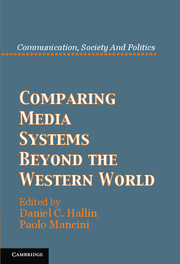12 - Comparing Processes
Media, “Transitions,” and Historical Change
from Part II - Methods and Approaches
Published online by Cambridge University Press: 05 June 2012
Summary
Introducing their seminal volume, Hallin and Mancini (2004b) pay tribute to Siebert, Peterson, and Schramm's (1956) Four Theories of the Press, acknowledging the validity of the general question the authors of the Four Theories were interested in – namely, how and why is it that “the press always takes on the form and coloration of the social and political structures within which it operates” (Siebert et al., 1956: 2). However, the authors of Comparing Media Systems part company with the authors of the Four Theories as they shift their focus from the political philosophies that Siebert et al. presumed undergird the flavor, “form and coloration” of mass media around the world. Instead, Hallin and Mancini (2004b) focus on empirical analyses of relations between media and politics in particular locales in Western Europe and North America and on the rootedness of those relations in specific histories of social and political change.
Yet, despite Hallin and Mancini's admirable wish to give the Four Theories “a decent burial and move on,” two aspects of their seminal work continue to bear resemblance to some of the original tenets of the Four Theories. The first aspect is Hallin and Mancini's commitment to the continual search for models of media and politics (as per the book's subtitle), albeit with the crucial stipulation that the models proposed in the 2004 volume are empirical, not normative. Second is their commitment to analyze relations between media and politics worldwide on a systems level (as per the book's title), but again, with the crucial specification that media systems are often dynamic, not always stable, and undergo constant historical change.
- Type
- Chapter
- Information
- Comparing Media Systems Beyond the Western World , pp. 246 - 277Publisher: Cambridge University PressPrint publication year: 2011
- 10
- Cited by

